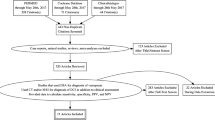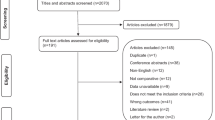Abstract
Objectives
To examine the accuracy of transcranial Doppler to detect cerebral vasospasm in a patient population with aneurysmal subarachnoid hemorrhage.
Design
Prospective blind comparison of transcranial Doppler with cerebral angiography. Diagnostic accuracy of transcranial Doppler was assessed using receiver operating characteristic (ROC) analysis and likelihood ratios. Sensitivity and specificity were calculated using directly measured middle cerebral artery diameter as reference standard.
Setting
Intensive Care Unit of a large university teaching hospital.
Patients and participants
Twenty-two patients with subarachnoid hemorrhage were included. Patients underwent angiography on admission and after 8 days to diagnose vasospasm and were defined as having clinical vasospasm, angiographic vasospasm, or no vasospasm.
Measurements and results
Sensitivity and specificity were 1.00 and 0.75 for angiographic vasospasm and both equal to 1.00 for clinical vasospasm diagnosis. A transcranial Doppler mean velocity threshold value of 100 cm/s for angiographic vasospasm and 160 cm/s for clinical vasospasm detection were chosen by ROC analysis.
Conclusions
A Transcranial Doppler mean velocity threshold of 160 cm/s, calculated by the ROC analysis, accurately detects clinical vasospasm. A daily transcranial Doppler examination performed by a trained operator should be routinely used to provide early identification of patients at high risk and to orient therapeutic decisions.

Similar content being viewed by others
References
Kassell NF, Torner JC, Haley EC Jr, Jane JA, Adams HP, Kongable GL, and participants (1990) The International Cooperative Study on the Timing of Aneurysm Surgery. Part 1: overall management results. J Neurosurg 73:18–36
Mayberg MR, Batjer HH, Dacey R, Diringer M, Haley C, Heros RC, Sternau LL, Torner J, Adams HP, Feinberg W, Thies W (1994) Guidelines for the management of aneurysmal subarachnoid hemorrhage. Stroke 25:2315–2328
Cloft HJ, Joseph GJ, Dion JE (1999) Risk of cerebral angiography in patients with subarachnoid hemorrhage, cerebral aneurysm, and arteriovenous malformation: a meta-analysis. Stroke 30:317–320
Aaslid R, Huber P, Nornes H (1984) Evaluation of cerebrovascular spasm with transcranial Doppler ultrasound. J Neurosurg 60:37–41
Wardlaw JM, Offin R, Teasdale GM, Teasdale EM (1998) Is routine transcranial Doppler ultrasound monitoring useful in the management of subarachnoid hemorrhage? J Neurosurg 88:272–276
Grosset DG, Straiton J, du Trevou M, Bullock R (1992) Prediction of symptomatic vasospasm after subarachnoid hemorrhage by rapidly increasing transcranial Doppler velocity and cerebral blood flow changes. Stroke 23:674–679
Sloan MA, Haley EC, Kassell NF, Henry ML, Stewart SR, Beskin RR, Sevilla EA, Torner JC (1989) Sensitivity and specificity of transcranial Doppler ultrasonography in the diagnosis of vasospasm following subarachnoid haemorrhage. Neurology 39:1514–1518
Vora YY, Suarez-Almazor M, Steinke DE, Martin ML, Findlay JM (1999) Role of transcranial Doppler monitoring in the diagnosis of cerebral vasospasm after subarachnoid hemorrhage. Neurosurgery 44:1237–1247
Lysakowski C, Walder B, Costanza MC, Tramer MR (2001) Transcranial Doppler versus angiography in patients with vasospasm due to a ruptured cerebral aneurysm: a systematic review Stroke 32:2292–2298
Griner PF, Mayewski RJ, Mushlin AI, Greenland P (1981) Selection and interpretation of diagnosic tests and procedures: principles and applications. Ann Intern Med 94:553–600
Drake CG (1988) Report of World Federation of Neurological Surgeons Committee on a Universal Subarachnoid Hemorrhage Grading Scale. J Neurosurg 68:985–986
Fisher CM, Kistler JP, Davis JM (1980) Relation of cerebral vasospasm to subarachnoid hemorrhage visualized by computerized tomographic scanning. Neurosurgery 6:1–9
Teasdale G, Jennett B (1974) Assessment of coma and impaired consciousness. A practical scale. Lancet 2:81–84
Greenhalgh T (1997) How to read a paper. Papers that report diagnostic or screening tests. BMJ 315:540–543
Obuchowski NA, Lieber ML (2002) Confidence bounds when the estimated ROC area is 1.0 Acad Radiol 9:526–530
Compton JS, Redmond S, Symon L (1987) Cerebral blood velocity in subarachnoid hemorrhage: a transcranial Doppler study. J Neurol Neurosurg Psychiatry 50:1499–1503
Lindegaard KF, Nornes H, Bakke SJ, Sorteberg W, Nakstad P (1988) Cerebral vasospasm after subarachnoid hemorrhage investigated by means of transcranial Doppler ultrasound. Acta Neurochir [Suppl 42]:81–84
Sekhar LN, Wechsel LR, Yonas H, Luyckx K, Obrist W (1988) Value of transcranial Doppler examination in the diagnosis of cerebral vasospasm after subarachnoid hemorrhage. Neurosurgery 22:813–821
Hutchison K, Weir B (1989) Transcranial Doppler studies in aneurysm patients. Can J Neurol Sci 16:411–416
Seiler RW, Grolimund P, Aaslid R, Huber P, Nornes H (1986) Cerebral vasospasm evaluated by transcranial ultrasound correlated with clinical grade and CT-visualized subarachnoid hemorrhage. J Neurosurg 64:594–600
Clyde BL, Resnick DK, Yonas H, Smith HA, Kaufmann AM (1996) The relationship of blood velocity as measured by transcranial Doppler ultrasonography to cerebral blood flow as determined by stable xenon computed tomographic studies after aneurysmal subarachnoid hemorrhage. Neurosurgery 38:896–904
Suarez JI, Qureshi AI, Yahia AB, Parekh PD, Tamargo RJ, Williams MA, Ulatowski JA, Hanley DF, Razumovsky AY (2002) Symptomatic vasospasm diagnosis after subarachnoid hemorrhage: evaluation of transcranial Doppler ultrasound and cerebral angiography as related to compromised vascular distribution. Crit Care Med 30:1348–1355
Proust F, Callonec F, Clavier E, Lestrat JP, Hannequin D, Thiebot J, Freger P (1999) Usefulness of transcranial color-coded sonography in the diagnosis of cerebral vasospasm. Stroke 30:1091–1098
Bejjani GK, Bank WO, Olan WJ, Sekhar LN (1998) The efficacy and safety of angioplasty for cerebral vasospasm after subarachnoid hemorrhage. Neurosurgery 42:979–986
Bruden N, Cohen B, Pellissier D, Francois G. (1998) The effect of hemodilution on cerebral blood flow velocity in anesthetized patients. Anesth Analg 86:320–324
Manno EM, Gress DR, Schwamm LH, Diringer MN, Ogilvy CS (1998) Effects of induced hypertension on transcranial doppler ultrasound velocities in patients after subarachnoid hemorrhage. Stroke 29:422–428
Harper M, Glass HI (1965) Effect of alterations in the carbon dioxide tension on the blood flow through the cerebral cortex at normal and low blood pressures. J Neurol Neurosurg Psychiatry 28:449–452
Maeda H, Etani H, Handa N, Tagaya M, Oku N, Kim BH, Naka M, Kinoshita N, Nukada T, Fukunaga R (1990) A validation study on the reproducibility of transcranial Doppler velocimetry. Ultrasound Med Biol 16:9–14
Shen Q, Stuart J, Venkatesh B, Wallace J, Lipman J (1999) Interobserver variability of the transcranial doppler ultrasound technique. Impact of lack of practice on the accuracy of measurement. J Clin Monit Comp 15:179–184
Itoh T, Matsumoto M, Handa N, Maeda H, Hougaku H, Hashimoto H, Etani H, Tsukamoto Y, Kamada T (1993) Rate of successful recording of blood flow signals in the middle cerebral artery using transcranial Doppler sonography. Stroke 24:1192–1195
Bogdahn U, Becker G, Winkler J, Greiner K, Perez J, Meurers B (1990) Transcranial color-coded real-time sonography in adults. Stroke 21:1680–1688
Newell DW, Grady MS, Eskridge JM, Winn HR (1990) Distribution of angiographic vasospasm after subarachnoid hemorrhage: implications for diagnosis by transcranial Doppler ultrasonography. Neurosurgery 27:574–577
Laumer R, Steinmeier R, Gonner F, Vogtmann T, Priem R, Fahlbusch R (1993) Cerebral hemodynamics in subarachnoid hemorrhage evaluated by transcranial Doppler sonography. Part 1. Reliability of flow velocities in clinical management. Neurosurgery 33:1–8
Venkatesh B, Shen Q, Lipman J (2002) Continuous measurement of cerebral blood flow velocity using transcranial Doppler reveals significant moment-to-moment variability of data in healthy volunters and in patients with subarachnoid hemorrhage. Crit Care Med 30:563–569
Acknowledgments
The authors thank DWL, Elektronische Systeme, Supplingen, Germany for kindly supplying the Doppler equipment, and Foundation Baxter and Alma Ricard Chair in cerebrovascular surgery, University of Toronto for supporting the study.
Author information
Authors and Affiliations
Corresponding author
Additional information
Dr L. Mascia was supported by the PhD program in Applied Physiology, University of Turin, Italy.
Rights and permissions
About this article
Cite this article
Mascia, L., Fedorko, L., terBrugge, K. et al. The accuracy of transcranial Doppler to detect vasospasm in patients with aneurysmal subarachnoid hemorrhage. Intensive Care Med 29, 1088–1094 (2003). https://doi.org/10.1007/s00134-003-1780-5
Received:
Accepted:
Published:
Issue Date:
DOI: https://doi.org/10.1007/s00134-003-1780-5




